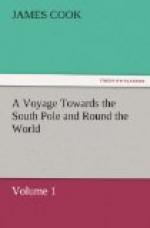In this last island, Mendana, with many of his companions, died; and the shattered remains of the squadron were conducted to Manilla, by Pedro Fernandes de Quiros, the chief pilot.
1605 Quiros.
This same Quiros was the first sent out, with the sole view of discovering a southern continent, and, indeed, he seems to have been the first who had any idea of the existence of one.
He sailed from Callao the 21st of December, 1605, as pilot of the fleet, commanded by Luis Paz de Torres, consisting of two ships and a tender; and steering to the W.S.W., on the 26th of January, 1606. being then, by their reckoning, a thousand Spanish leagues from the coast of America, they discovered a small low island in latitude 26 deg. S. Two days after, they discovered another that was high, with a plain on the top. This is probably the same that Captain Carteret calls Pitcairn’s Island.
After leaving these islands, Quiros seems to have directed his course to W.N.W. and N.W. to 10 deg. or 11 deg. S. latitude, and then westward, till he arrived at the Bay of St Philip and Jago, in the Island of Tierra del Espirito Santo. In this route be discovered several islands; probably some of those that have been seen by later navigators.
On leaving the bay of St Philip and St Jago, the two ships were separated. Quiros, with the Capitana, stood to the north, and returned to New Spain, after having suffered greatly for want of provisions and water. Torres, with the Almiranta and the tender, steered to the west, and seems to have been the first who sailed between New Holland and New Guinea.
1615. Le Maire and Schouten
The next attempt to make discoveries in the South Pacific Ocean, was conducted by Le Maire and Schouten. They sailed from the Texel, on the 14th of June, 1615, with the ships Concord and Horn. The latter was burnt by accident in Port Desire. With the other they discovered the straits that bear the name of Le Maire, and were the first who ever entered the Pacific Ocean, by the way of Cape Horn.
They discovered the island of Dogs, in latitude 15 deg. 15’ S., longitude 136 deg. 30’ W.; Sondre Grondt in 15 deg. S. latitude, and 143 deg. 10’ W. longitude; Waterland in 14 deg. 46’ S., and 144 deg. 10’ W.; and twenty-five leagues westward of this, Fly Island, in latitude 15 deg. 20’; Traitor’s and Coco’s Islands, in latitude 15 deg. 43’ S., longitude 173 deg. 13’ W.; two degrees more to the westward, the isle of Hope; and in the latitude of 14 deg. 56’ S., longitude 179 deg. 30’ E., Horn Island.
They next coasted the north side of New Britain and New Guinea, and arrived at Batavia in October, 1616.
1642 Tasman.
Except some discoveries on the western and northern coasts of New Holland, no important voyage to the Pacific Ocean was undertaken till 1642, when Captain Tasman sailed from Batavia, with two ships belonging to the Dutch East India Company, and discovered Van Diemen’s Land; a small part of the western coast of New Zealand; the Friendly Isles; and those called Prince William’s.




